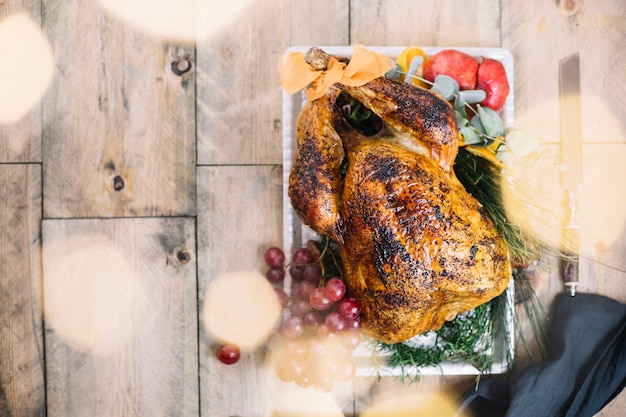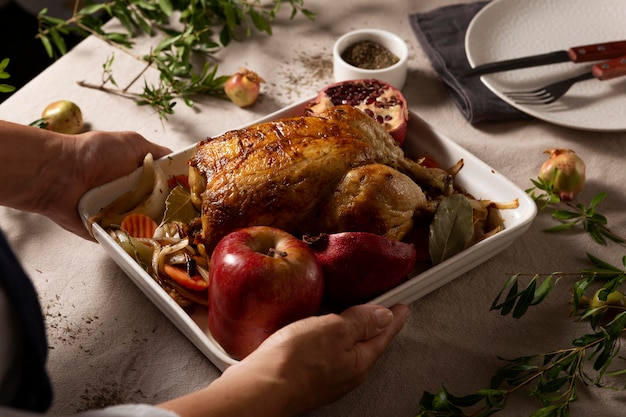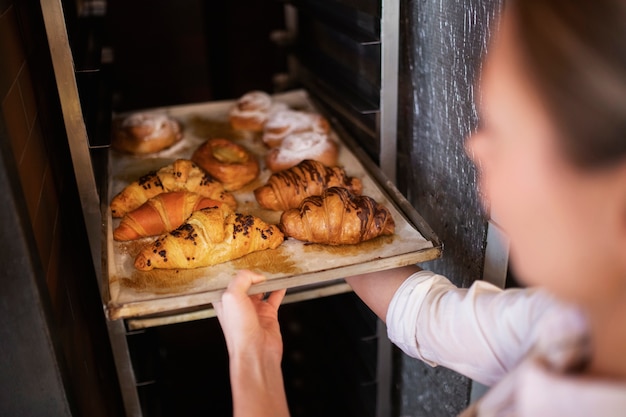You’re craving perfectly cooked chicken breast, but the oven timer is ticking, and you’re unsure how long to bake it at 400 degrees. Been there, done that! I’ve had my fair share of dry, overcooked chicken disasters. But, over time, I've learned a few tricks that guarantee juicy, flavorful chicken breast every time. It’s all about mastering that baking time. Grab a pen and paper (or just bookmark this page!), because we’re diving deep into the world of 400-degree chicken breast baking. Buckle up, this is going to be delicious!
(Part 1) The Foundations: Understanding Baking Time

Let’s get the basics down. The time it takes to bake chicken breast at 400 degrees depends on several factors.
1. Size Matters (Just Like It Does in Life)
You know how they say “size matters?” Well, it definitely does when it comes to chicken breast! A smaller breast will cook faster than a large one. It's all about surface area to volume ratio, you see. More surface area means faster cooking, and a smaller breast has a higher ratio of surface area to volume. For a standard 6-ounce chicken breast, baking at 400 degrees should take around 20 minutes. However, always err on the side of caution. You can always bake it a little longer, but you can’t uncook it!
2. Thickness is the Other Key
Just like size, the thickness of your chicken breast plays a major role in how long it takes to cook. A thinner breast will cook quicker, while a thicker one will need a bit more time. For a typical 1-inch thick chicken breast, baking at 400 degrees will take about 20-25 minutes. But again, always check with a meat thermometer! You want that internal temperature to reach 165 degrees Fahrenheit for safe and delicious chicken.
3. Your Oven Has a Personality (Just Like You!)
Every oven has its quirks. Some run a bit hotter than others, so it's a good idea to calibrate your oven before baking. You can use an oven thermometer to make sure it's running at the correct temperature. If your oven tends to run a little hot, you might need to adjust the baking time slightly.
4. Baking Multiple Breasts? Adjust Your Time
Let’s talk about what happens if you’re baking more than one chicken breast at a time. If you’re baking two or more chicken breasts, it's best to spread them out in the baking dish. This allows for even heat distribution and prevents them from steaming each other, which can lead to longer cooking times. I usually add 5-10 minutes to the total baking time for every additional breast.
(Part 2) The Art of the Bake: Tips and Tricks for perfect chicken

We’ve covered the basics. But how do we get that perfectly juicy, flavorful chicken breast? There are a few tips and tricks that I’ve picked up over the years, and I’m happy to share them with you.
1. The Importance of Preheating: A Warm-Up for Your Chicken
Preheating your oven to 400 degrees is essential, just like warming up before a workout! It ensures that your chicken cooks evenly and quickly. I usually preheat my oven for about 10-15 minutes, giving it plenty of time to reach the desired temperature.
2. Seasoning is Key: Adding Depth and Flavor
You can’t expect boring chicken to become a culinary masterpiece! Seasoning is key to adding flavor and depth to your chicken breast. I like to use a simple salt and pepper blend, but you can get creative with herbs, spices, and marinades. Try a simple marinade with olive oil, lemon juice, and garlic for an extra burst of flavor. Let it marinate for at least 30 minutes, and you’ll be amazed by the difference it makes!
3. The Magic of Butter: A Warm Hug for Your Chicken
A little bit of butter goes a long way! I love to rub a thin layer of butter over my chicken breast before baking. This helps to keep it moist and adds a delightful richness. It’s like a warm hug for your chicken!
4. The Right Pan Makes All the Difference: A Home for Your Chicken
You can’t just throw your chicken breast on a bare baking sheet, no sir! Using a baking dish is essential for even cooking and prevents your chicken from sticking. I love to use a glass baking dish. It allows me to monitor the cooking process and ensures that the chicken is evenly cooked.
5. The Thermometer Test: Your Chicken's Temperature is Crucial
Remember what I said about size and thickness? The most reliable way to know if your chicken breast is cooked through is to use a meat thermometer. It’s a game-changer! You want the internal temperature to reach 165 degrees Fahrenheit. Anything less, and you’re risking food poisoning.
(Part 3) Cooking Time Variations: Beyond 400 Degrees

So far, we’ve focused on baking chicken breasts at 400 degrees, but what if you want to experiment with different temperatures? Well, I’m here to tell you that you can definitely get away with using other temperatures as well.
1. The 350-Degree Bake: Slow and Steady Wins the Race
If you prefer a slower, more gentle cooking method, baking at 350 degrees is a great option. It will take a bit longer, but it’s a great way to ensure a juicy and tender chicken breast. Just keep in mind that you might need to increase the baking time by 10-15 minutes.
2. The 375-Degree Bake: A Happy Medium for Deliciousness
This is a happy medium between 350 and 400 degrees. It’s a good option if you want a quicker cook than 350 degrees but not as fast as 400 degrees. It’s a great choice for those who want a balanced result.
3. The High-Heat Bake: For crispy skin and Juicy Interior
Now, if you’re looking for a quicker cook, you could try baking at 425 degrees. This will give you a crispy skin and juicy interior, but it requires extra vigilance. You'll need to shorten the cooking time to 15-20 minutes and make sure you check the chicken frequently with a meat thermometer.
(Part 4) delicious chicken breast Recipes: Time to Get Creative
Alright, now that you’ve mastered the art of baking chicken breast at 400 degrees, let’s talk about some delicious recipes to inspire you. I’ve got a few personal favorites that I’m happy to share.
1. Lemon Herb Chicken Breast: A Classic for a Reason
This is a classic recipe that’s always a crowd-pleaser! You’ll need a few simple ingredients:
- Chicken breast (1-inch thick)
- Olive oil
- Lemon juice
- Garlic powder
- Dried oregano
- Salt and pepper
Preheat your oven to 400 degrees. Mix together the olive oil, lemon juice, garlic powder, oregano, salt, and pepper. Rub the mixture all over the chicken breast. Bake for 20-25 minutes, or until the internal temperature reaches 165 degrees Fahrenheit. You can serve it with a side of roasted vegetables or a salad for a complete meal.
2. Honey Garlic Chicken Breast: Sweet and Savory Perfection
This recipe is super flavorful and easy to make! You’ll need:
- Chicken breast (1-inch thick)
- Honey
- Soy sauce
- Garlic powder
- Ginger
- Salt and pepper
Preheat your oven to 400 degrees. In a small bowl, whisk together the honey, soy sauce, garlic powder, ginger, salt, and pepper. Rub the mixture all over the chicken breast. Bake for 20-25 minutes, or until the internal temperature reaches 165 degrees Fahrenheit. Serve it with rice or noodles for a satisfying meal.
3. Parmesan Crusted Chicken Breast: Elegant and Easy
This recipe is a simple yet elegant way to dress up your chicken breast! You’ll need:
- Chicken breast (1-inch thick)
- Parmesan cheese, grated
- Breadcrumbs
- Olive oil
- Salt and pepper
Preheat your oven to 400 degrees. In a small bowl, combine the Parmesan cheese, breadcrumbs, salt, and pepper. Dip the chicken breast in olive oil and then press it into the cheese and breadcrumb mixture. Place the chicken breast on a baking sheet and bake for 20-25 minutes, or until the internal temperature reaches 165 degrees Fahrenheit. Serve it with a side of pasta or mashed potatoes.
(Part 5) Chicken Breast Baking Mistakes to Avoid: Don't Let Your Dinner Go Wrong
We’ve all been there, right? A slight slip-up in the kitchen, and suddenly our perfectly planned meal is a disaster. When it comes to baking chicken breast, there are a few common mistakes to watch out for.
1. Overcrowding the Baking Sheet: Give Your Chicken Some Space
This is a big no-no! If you overcrowd the baking sheet, the chicken breasts won’t cook evenly, and they might even steam each other, leading to a longer cooking time and a less-than-desirable texture. Always give your chicken breasts some breathing room.
2. Not Checking the Temperature: Use Your Meat Thermometer Wisely
We’ve already discussed this, but it’s worth repeating: always check the internal temperature of your chicken breast with a meat thermometer. Don’t rely on visual cues alone. It’s the only way to ensure that your chicken is cooked through and safe to eat.
3. Overcooking: Avoid Dry, Tough Chicken
Overcooking is a common mistake, and it leads to dry, tough chicken. Once you reach that 165-degree Fahrenheit mark, take the chicken out of the oven. It’s better to err on the side of undercooked than overcooked.
4. Forgetting to Rest: A Few Minutes for Juiciness
This is a tip that often gets overlooked, but it’s crucial for tender and juicy chicken. After you remove the chicken from the oven, let it rest for 5-10 minutes before slicing and serving. This allows the juices to redistribute, resulting in a more flavorful and tender chicken breast.
(Part 6) Chicken Breast Storage and Leftovers: Making the Most of Your Dinner
So, you’ve got your delicious, perfectly cooked chicken breast, but what about leftovers? Well, I’ve got you covered.
1. Storing Chicken Breast: Keeping It Fresh and Safe
Properly storing chicken breast is essential to prevent spoilage and ensure it stays safe to eat. After it’s cooled down, place it in an airtight container in the refrigerator and it should last for 3-4 days. You can also freeze it for up to 3 months. Just make sure to wrap it tightly in plastic wrap or aluminum foil to prevent freezer burn.
2. Leftover chicken breast recipes: Creative Ways to Use It
leftover chicken breast is a blank canvas for culinary creativity! You can add it to salads, sandwiches, soups, or even use it as a base for pasta dishes. Here are a few of my favorite ways to use leftover chicken:
- chicken salad Sandwiches: Combine leftover chicken with mayonnaise, celery, onion, and a dash of salt and pepper. Spread it on bread and enjoy a simple and satisfying lunch or snack.
- chicken noodle soup: Throw some leftover chicken into your favorite chicken noodle soup recipe. It adds a burst of flavor and protein.
- Chicken Stir-Fry: Slice up leftover chicken and toss it with your favorite vegetables for a quick and easy stir-fry.
- Chicken Quesadillas: Layer leftover chicken with cheese and your favorite toppings in a tortilla. Grill it until the cheese is melted and enjoy a delicious quesadilla.
- Chicken Pasta Salad: Combine leftover chicken with your favorite pasta, vegetables, and a creamy dressing for a flavorful and satisfying pasta salad.
- Chicken Pizza: Top your favorite pizza crust with leftover chicken, cheese, and your favorite toppings for a delicious and easy pizza.
(Part 7) Chicken Breast Baking: A Final Word and Your Next culinary adventure Awaits
And that’s a wrap! We’ve covered everything you need to know about baking chicken breast at 400 degrees. Remember, it’s all about the basics: size, thickness, and preheating. Season it well, use a meat thermometer, and don’t be afraid to experiment with different temperatures and recipes.
So go forth, my friends, and conquer the art of baking chicken breast! And remember, I’m always here if you have any questions or need a little extra guidance along the way.
FAQs
1. How do I know if my chicken breast is cooked through without a meat thermometer?
While a meat thermometer is the most reliable way to ensure your chicken is cooked through, you can use a few visual cues as well. The chicken should be white all the way through, with no pink remaining. It should also be firm to the touch. However, it’s always best to err on the side of caution and use a meat thermometer, especially if you’re unsure.
2. What should I do if my chicken breast is overcooked?
If your chicken breast is overcooked and dry, there isn’t much you can do to remedy the situation. However, you can try to salvage it by adding a flavorful sauce or topping. A creamy sauce or a tangy marinade can help to mask the dryness. You can also add some fresh herbs or spices for extra flavor. You can also try using the leftover chicken in a dish where the texture isn't as important, like chicken salad or a soup.
3. Can I bake chicken breast with the skin on?
Yes, you can bake chicken breast with the skin on. In fact, it can result in a crispier, more flavorful chicken breast. Just make sure to score the skin before baking to allow the fat to render and create a crispy texture.
4. How long can I keep leftover chicken breast in the refrigerator?
Leftover chicken breast can be safely stored in the refrigerator for 3-4 days. Make sure to store it in an airtight container to prevent spoilage.
5. What are some healthy ways to cook chicken breast?
Baking chicken breast is a healthy way to cook it, as it requires minimal added fat. Other healthy cooking methods include grilling, poaching, or stir-frying.
6. What if my chicken breast is still pink in the middle?
If your chicken breast is still pink in the middle, it’s important to cook it further to ensure it’s safe to eat. Place it back in the oven and continue baking for an additional 5-10 minutes, or until the internal temperature reaches 165 degrees Fahrenheit. Always check the internal temperature with a meat thermometer to make sure it’s cooked through.
7. Can I bake chicken breast in a slow cooker?
Yes, you can bake chicken breast in a slow cooker. This is a great option for a hands-off meal. Simply place the chicken breast in the slow cooker with your favorite seasonings, and cook on low for 4-6 hours, or on high for 2-3 hours, until the internal temperature reaches 165 degrees Fahrenheit.
8. What are some tips for preventing dry chicken breast?
Here are some tips for preventing dry chicken breast:
- Don't overcook it. Make sure to check the internal temperature with a meat thermometer and remove the chicken from the oven once it reaches 165 degrees Fahrenheit.
- Use a marinade. Marinating the chicken breast in a flavorful liquid, such as olive oil, lemon juice, or soy sauce, can help to keep it moist and tender.
- Baste the chicken. During the baking process, periodically baste the chicken with pan juices or a flavorful sauce to keep it moist.
Enjoy your perfectly cooked chicken breast, and happy baking!
Everyone is watching

Corn on the Cob: The Ultimate Guide to Perfectly Cooked Ears
Healthy MealsAh, corn on the cob. Just the name evokes images of sunny days, barbecues, and that sweet, juicy flavour that ...

Perfect Pork Roast Oven Cooking Time: A Guide to Delicious Results
Healthy MealsThere's something truly satisfying about a perfectly roasted pork. The aroma alone is enough to make your mout...

Scallops: The Ultimate Guide to Perfect Cooking
Healthy MealsAh, scallops. Those delicate, sweet, and utterly delicious morsels of the sea. They hold a special place in my...

Ham Cooking Time: How Long to Bake, Smoke, or Boil a Delicious Ham
Healthy MealsAh, ham. It's a classic, isn't it? A real crowd-pleaser, especially around holidays. And when done right, it'...

Spaghetti Squash: The Ultimate Guide to Cooking and Serving
Healthy MealsRemember that time you saw spaghetti squash at the supermarket, looking all bumpy and strange, and thought, "W...
